中英颜色,动物,数字文化差异原则(中西差异)英语版
中西方文化中中的动物差异(英文版)

The Difference of Animals Between China and English Language reflects culture. Chinese culture is typical intensive cultivation and is rooted in agriculture. Therefore, many Chinese sayings are connected with land, agriculture or farming activities. English culture, on the contrary, is coastal commerce and there are many sayings closely linked with sea, sailing and fishing activities.Now let me show you some details of animal differences between China and English in the followings:Snakes are dangerous animals in both English and Chinese cultures. In ancient Chinese or in Chinese mythology, however, the snake and dragon sometimes are inseparable. Fu Xi and Nv Wa are regarded as the first ancestors of the Chinese nation who are said to have a human-head with a snake with a snake body. People who were born in the year of the snake also say that they were born in the year of the young dragon. This associative meaning of the snake is in a positive sense.A dragon is an evil and strong embodiment in English. It often causes great disasters and guards some mysterious fortunes, as is told in British legends. In Chinese culture, on the contrary, a dragon is a symbol of extreme honor and great power.Westerners take dogs as their friends and companions, so that in English dogs are used in the commendatory sense in most cases. The connotation of the dog in Chinese is more derogatory, except a few cases indicating the loyalty to its master.There are also some common sayings about animals in our daily life, it is very convenient for us to express, for instance:Top dog 优胜者Clever dog聪明的小孩Big dog要人Dead dog没用的人Under dog 失败者Dirty dog道德败坏的人Dumb dog沉默寡言的人Gay dog快活的人Laze dog 懒汉Sea dog 老手Love me, love my dog.爱屋及乌Every dog has its day.凡人皆有得意日Give a dog a bad name and hang it.欲加之罪,何患无词You dog.你这狗东西That dog.那狗东西A lion at home, a mouse abroad.在家如狮,在外如鼠。
中西文化差异(英文版)

culture is the biggest festival, food,
one.
music, wedding
and so on.Now I
want to introduce
something about
it.
Chinese custom festival
The Spring Festival The Lantern Festival The Mid Autumn Festival The Dragon-Boat Festival The Tomb-sweeping Festival The Double-ninth Day The Double Seventh Festival
Western custom festival
The Christmas Day The Easter Day The Thanksgiving Day The April Fool‘s Day The Mother‘s Day The Father‘s Day Halloween The Valentine’s Day
to west countries, you can take part in their joyful night life.
East&West
• A Chinese hostess will apologize for giving you “Nothing”. She will say“I just made some dishes casually and they are not very tasty.”
But in most west countries, people live in a easy and happy
中西方数字文化差异英语作文
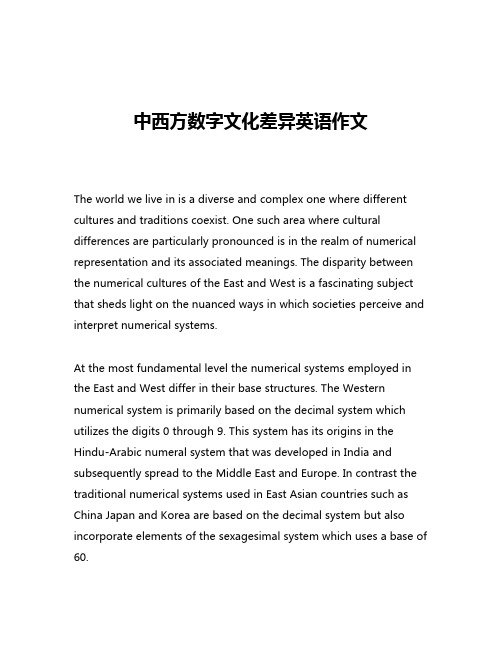
中西方数字文化差异英语作文The world we live in is a diverse and complex one where different cultures and traditions coexist. One such area where cultural differences are particularly pronounced is in the realm of numerical representation and its associated meanings. The disparity between the numerical cultures of the East and West is a fascinating subject that sheds light on the nuanced ways in which societies perceive and interpret numerical systems.At the most fundamental level the numerical systems employed in the East and West differ in their base structures. The Western numerical system is primarily based on the decimal system which utilizes the digits 0 through 9. This system has its origins in the Hindu-Arabic numeral system that was developed in India and subsequently spread to the Middle East and Europe. In contrast the traditional numerical systems used in East Asian countries such as China Japan and Korea are based on the decimal system but also incorporate elements of the sexagesimal system which uses a base of 60.This difference in base structures has led to some interesting divergences in the way numbers are conceptualized and expressed. For instance in the Chinese language individual digits are assigned unique names rather than simply being referred to by their numerical value. The number 4 for example is known as "si" while 7 is "qi". This stands in contrast to the more straightforward numerical naming conventions used in Western languages. Additionally Chinese numerals are written using logographic characters rather than the alphabetic digits employed in the West further emphasizing the distinct visual representation of numbers.The cultural significance assigned to certain numbers also varies greatly between Eastern and Western societies. In the West the number 13 is often viewed with superstition and considered to be unlucky. This belief is so pervasive that many buildings omit a 13th floor and airports lack a Gate 13. In contrast in China the number 4 is widely regarded as unlucky due to its phonetic similarity to the word for "death" in Mandarin. As a result Chinese buildings and product packaging frequently skip the fourth floor or fourth item in a series.Numerical symbolism also manifests in more subtle ways. In Western countries even numbers are often perceived as more balanced and harmonious while odd numbers are seen as less stable. This preference for even numbers can be observed in the layout of buildings the design of consumer products and the organization ofevents. Conversely in East Asian cultures odd numbers are frequently associated with masculinity and vitality while even numbers symbolize femininity and passivity.These divergent attitudes towards numbers extend to their practical applications as well. In the business world for instance Chinese negotiators may place a higher premium on auspicious numbers when making deals. The number 8 for example is considered extremely lucky in China due to its phonetic similarity to the word for "prosperity". As a result Chinese companies may deliberately choose addresses or phone numbers containing multiple 8s. Western business practices on the other hand tend to be more pragmatic and numbers-driven with less emphasis on symbolic significance.Differences in numerical culture can also be seen in the realm of personal names. In the West names are often chosen for their meaning sound or connection to family heritage. Numerical considerations play a relatively minor role. However in China and other East Asian societies the selection of names with favorable numeric associations is extremely important. Parents will carefully choose characters for their children's names that incorporate lucky numbers or avoid unlucky ones. The goal is to endow the individual with positive numeric energy that will bring good fortune and success throughout their life.Ultimately the divergent attitudes towards numbers between Eastern and Western societies stem from deep-rooted cultural traditions and philosophical worldviews. The decimal-based numerical system used in the West reflects a linear and quantitative approach to mathematics and problem-solving. In contrast the incorporation of sexagesimal elements and symbolic number associations in East Asian numerical culture points to a more holistic and qualitative understanding of the role of numbers in the universe.These fundamental differences have profound implications not just for how numbers are perceived and utilized but for the broader mindsets and behaviors that characterize Eastern and Western societies. As the world becomes increasingly interconnected it is crucial to develop a nuanced appreciation for these cross-cultural numerical distinctions. Only then can we navigate the complexities of a globalized world with greater cultural sensitivity and mutual understanding.。
中外颜色文化差异英文作文
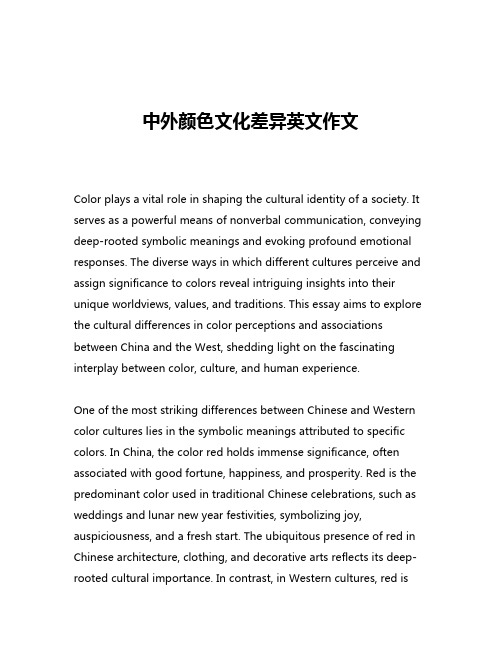
中外颜色文化差异英文作文Color plays a vital role in shaping the cultural identity of a society. It serves as a powerful means of nonverbal communication, conveying deep-rooted symbolic meanings and evoking profound emotional responses. The diverse ways in which different cultures perceive and assign significance to colors reveal intriguing insights into their unique worldviews, values, and traditions. This essay aims to explore the cultural differences in color perceptions and associations between China and the West, shedding light on the fascinating interplay between color, culture, and human experience.One of the most striking differences between Chinese and Western color cultures lies in the symbolic meanings attributed to specific colors. In China, the color red holds immense significance, often associated with good fortune, happiness, and prosperity. Red is the predominant color used in traditional Chinese celebrations, such as weddings and lunar new year festivities, symbolizing joy, auspiciousness, and a fresh start. The ubiquitous presence of red in Chinese architecture, clothing, and decorative arts reflects its deep-rooted cultural importance. In contrast, in Western cultures, red isoften linked to notions of danger, passion, and aggression, with associations ranging from stop signs to the red carpet.Similarly, the color white holds vastly different connotations in the two cultural contexts. In the West, white is commonly associated with purity, innocence, and cleanliness, often used in wedding dresses and religious ceremonies. However, in Chinese culture, white is the color of mourning and is closely tied to death and funerals. The wearing of white garments during periods of bereavement is a longstanding tradition in China, reflecting the belief that white symbolizes the purity of the soul and the shedding of earthly attachments.The perception of the color black also differs significantly between China and the West. In Western societies, black is often viewed as a color of sophistication, elegance, and formality, commonly used in business attire and high-fashion. Conversely, in traditional Chinese culture, black is associated with the element of water, representing stability, calmness, and the primordial forces of nature. Black is also closely linked to the Taoist concept of yin, representing the dark, feminine, and receptive aspect of the universal duality.The symbolic associations of colors extend beyond their visual representations, influencing various aspects of cultural expression and social norms. In China, the color green is closely tied to theconcept of youth, vitality, and new beginnings, often used to signify hope and renewal. This is evident in the widespread use of green decorations during the Lunar New Year celebrations. Conversely, in the West, green is more commonly associated with the natural world, environmental consciousness, and financial prosperity, as seen in the widespread use of the color in currency and corporate branding.The divergent color preferences and associations between China and the West also manifest in their respective artistic and design traditions. Chinese ink paintings, for instance, often feature a harmonious interplay of black ink and negative white space, reflecting the yin-yang balance and the reverence for subtlety and restraint. In contrast, Western art and design have historically embraced a more vibrant and bold use of color, with the Renaissance and Impressionist movements exemplifying the celebration of color as a means of artistic expression.Furthermore, the cultural differences in color perceptions extend to the realm of psychology and human behavior. In China, the color yellow is revered as the "imperial color," associated with the Emperor and the divine mandate of heaven. This reverence for yellow is evident in the prevalence of golden hues in imperial architecture and the use of yellow in traditional Chinese court attire. In the West, however, yellow is often perceived as a cheerful and sunny color, with less pronounced cultural significance.The divergent attitudes towards color also influence the ways in which individuals from these cultural backgrounds interpret and respond to color-based stimuli. Studies have shown that Chinese individuals tend to exhibit a stronger emotional response to the color red, which is deeply ingrained in their cultural psyche, compared to their Western counterparts. Conversely, Westerners may be more attuned to the symbolic meanings of green, given its associations with nature and environmental consciousness in their cultural context.These cross-cultural differences in color perceptions and associations are not merely aesthetic preferences but rather deeply rooted in the historical, philosophical, and religious traditions of each society. They reflect the unique worldviews, values, and lived experiences that shape the collective consciousness of a culture. Understanding these nuances is crucial in fostering cross-cultural understanding, effective communication, and appreciation for the rich diversity of human expression.In conclusion, the cultural differences in color perceptions between China and the West offer a fascinating glimpse into the intricate tapestry of human civilization. From the symbolic meanings of specific colors to the ways in which they influence artistic expression and human behavior, these distinctions highlight the profoundimpact of culture on our perception and interpretation of the world around us. By embracing and celebrating these differences, we can gain a deeper understanding of the multifaceted nature of human experience and the remarkable diversity that enriches our global community.。
中西文化差异(数字、颜色、对事物的认识)
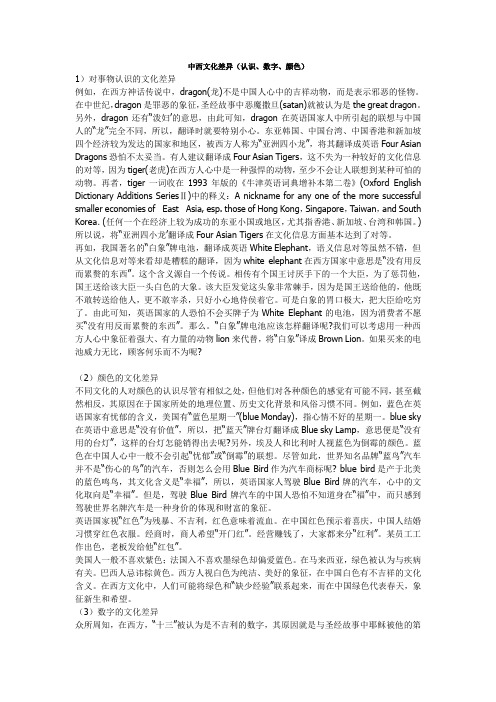
中西文化差异(认识、数字、颜色)1)对事物认识的文化差异例如,在西方神话传说中,dragon(龙)不是中国人心中的吉祥动物,而是表示邪恶的怪物。
在中世纪,dragon是罪恶的象征,圣经故事中恶魔撒旦(satan)就被认为是the great dragon。
另外,dragon还有“泼妇’的意思,由此可知,dragon在英语国家人中所引起的联想与中国人的“龙”完全不同,所以,翻译时就要特别小心。
东亚韩国、中国台湾、中国香港和新加坡四个经济较为发达的国家和地区,被西方人称为“亚洲四小龙”,将其翻译成英语Four Asian Dragons恐怕不太妥当。
有人建议翻译成Four Asian Tigers,这不失为一种较好的文化信息的对等,因为tiger(老虎)在西方人心中是一种强悍的动物,至少不会让人联想到某种可怕的动物。
再者,tiger一词收在1993年版的《牛津英语词典增补本第二卷》(Oxford English Dictionary Additions SeriesⅡ)中的释义:A nickname for any one of the more successful smaller economies of East Asia, esp. those of Hong Kong,Singapore,Taiwan,and South Korea.(任何一个在经济上较为成功的东亚小国或地区,尤其指香港、新加坡、台湾和韩国。
)所以说,将“亚洲四小龙’翻译成Four Asian Tigers在文化信息方面基本达到了对等。
再如,我国著名的“白象”牌电池,翻译成英语White Elephant,语义信息对等虽然不错,但从文化信息对等来看却是糟糕的翻译,因为white elephant在西方国家中意思是“没有用反而累赘的东西”。
这个含义源自一个传说。
相传有个国王讨厌手下的一个大臣,为了惩罚他,国王送给该大臣一头白色的大象。
中英颜色,动物,数字文化差异原则(中西差异)英语版

文化差异原则1.2、3、黄色4、蓝色5、文化差异问题是一个非常复杂的问题,英汉颜色词语的词义有时对应,有时相佐,有时无对应。
译者要在两种语言之间进行翻译,不仅要掌握两国的语言文字,而且要深刻理解两种文化之间的差异,在翻译时应该仔细推敲,谨慎处理。
2.动物差异语言是人类社会进行交际的重要工具,同时也是文化的重要载体。
不同民族的语言既受到本民族社会文化的制约,又反映各自特定的文化内容。
如果某一民族的人们不了解某一特定民族的文化因素,则不可能进行有效与顺利的交流。
因此,必须把语言知识和文化知识结合起来才能顺利地进行交流。
研究对外汉语教学的专家赵贤州先生(1992)说:“跨文化交际之所以成为可能,正是人类享有某些共同的文化信息;而跨文化交际之所以产生某些偏差,是因为双方不能共享另一些有差异的文化信息”。
英汉这两种各具特色却大相径庭的语言形式,其表达方式与文化习惯存在一定差异。
这些五彩斑斓、丰富多彩的表达方式与纷繁复杂的习惯差异是由于汉民族文化与英美民族文化之间存在着民族历史、社会制度、道德信仰、文学艺术、心理特点、风俗习惯、价值观念、思维方式、生活方式以及地域风貌等等差别。
只有充分了解英汉文化的背景知识,才能进行更有效、更顺利的交际。
在英语文化中把人的某种特点与动物相比较并不常见,但汉语言中却有很多这种比喻的例子。
通过上面这个小例子, 我们可以看出,如果在翻译中遇到这种与动物有关的比喻性句子时, 我们一定要考虑西方文化的因素,避免用中国人的习惯说法代替西方人的习惯说话。
这里还有这些搭配并不是固定不变的,比如bull(公牛)这种动物,经常跟angry(愤怒)搭配,但它也可以跟mad(疯狂)、strong(强壮)等搭配,因此千万不要搞教条,一定要灵活运用。
古代原始人与动物为伍,生活在深山密林之中,捕鱼狩猎,以野生动物为食,繁衍生长。
直到今天,动物仍然是人类生存与发展的物质基础之一,人类的生活一刻也离不开动物的存在。
中西方文化差异英文版1
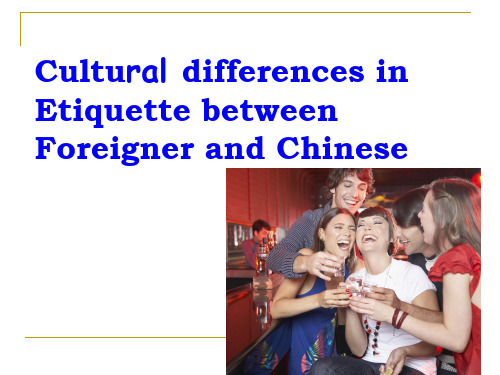
Thank you.
“Thank you” is widely used in English to show gratitude in such cases as being invited, helped, given a gift, etc.
9. Asking Personal Affairs
People from China do not regard it as asking personal affairs when they ask others name、age、marital status、 wages、personal life、belief and political points. It is regard as concerns.
For example, if a hostess is complimented for her cooking skill ,how she will response in west and china?
A Chinese hostess will apologize for giving you “Nothing”. She will say“I just made some dishes casually and they are not very tasty.”
While the westerns will think you violate their right of privacy .
10.Invitation
Chinese:welcome uninvited guest
Байду номын сангаас
Foreigners:consult a time before you invite somebody
对于颜色中西文化差异_英文版

Black White Yellow Red
Mr. Brown is a very white man. He was looking rather green the other day. He has been feeling blue lately. When I saw him, he was in a brown study. I hope he will soon be in the pink again. 布朗先生是一位忠实可靠的人。那天他脸色 不好,近来他一直闷闷不乐。我见到他的时 候,他显得心事重重。我希望他早点振作起 来。
Color
1、The different use of color in China and Western 2、Causes of cultural differences of colors
3、Conclusion
The different use of color in China and Western
② “yellow” 是腐化堕落的代名词,如: yellow journalism 在美国指不择手段地夸张,渲染以招揽或影响读 者的黄色办报作风。如突出社会丑闻,把普通新 闻写得耸人听闻,有时甚至歪曲事实以引起轰动。 yellow press 也是指刊载低级趣味的文字或耸人听闻的报道以 吸引读者的黄色报刊。
③ 在《圣经》中,黑便是黑暗,邪恶和妖魔的象征, 具有黑暗,邪恶,阴险,恐怖等贬义。如: Black hand (黑手党) 指在美国从事犯罪活动的一个意大利秘密组织。
Black Panther(黑豹 党) (指美国的黑人政党)
black Friday (黑色星期五) 1869年9月24日 Black Tuesday 1873年9月13日 (指1987年10月19日美 国华尔街股市崩溃, 接着世界各地股市随 之崩溃)
对于颜色中西文化差异_终稿

BLACK:
In western The "Bible“ says, the black represents the
devil, suffering and evil, a symbol of darkness, death, unfortunately.
Characteristic
Chinese:
intuition and perception ; through intuition, inspiration and imagination vagueness and mystery
Westerners:
abstract thinking and logical reasoning direct-viewing and clarity
a white lie
White:
White, opposite to red, is a basic taboo color in Chinese traditional culture. It is the expression of exhausted and nonblooded, non-life, and stands for death and ill omen.
读书破万卷,下笔如有神--杜甫
Interestingly, in business English, in the black have a good meaning, refers to the operating profit. Be in the black (profit) is the opposite be in red, these two terms are derived from the color of ink used when accounting. in the black-盈利
写一篇英语文章比较中英文中的颜色词 动物数字的含义不同
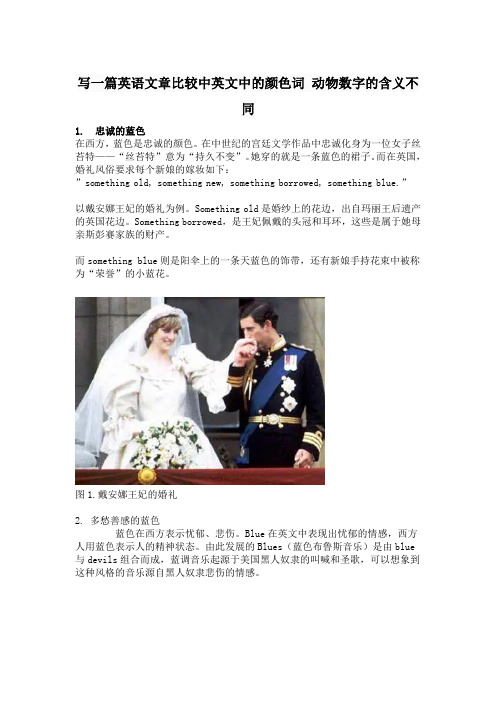
写一篇英语文章比较中英文中的颜色词动物数字的含义不同1. 忠诚的蓝色在西方,蓝色是忠诚的颜色。
在中世纪的宫廷文学作品中忠诚化身为一位女子丝苔特——“丝苔特”意为“持久不变”。
她穿的就是一条蓝色的裙子。
而在英国,婚礼风俗要求每个新娘的嫁妆如下:”something old, something new, something borrowed, something blue.”以戴安娜王妃的婚礼为例。
Something old是婚纱上的花边,出自玛丽王后遗产的英国花边。
Something borrowed,是王妃佩戴的头冠和耳环,这些是属于她母亲斯彭赛家族的财产。
而something blue则是阳伞上的一条天蓝色的饰带,还有新娘手持花束中被称为“荣誉”的小蓝花。
图1.戴安娜王妃的婚礼2. 多愁善感的蓝色蓝色在西方表示忧郁、悲伤。
Blue在英文中表现出忧郁的情感,西方人用蓝色表示人的精神状态。
由此发展的Blues(蓝色布鲁斯音乐)是由blue 与devils组合而成,蓝调音乐起源于美国黑人奴隶的叫喊和圣歌,可以想象到这种风格的音乐源自黑人奴隶悲伤的情感。
图2.布鲁斯之王 BB King图3.同上3. 高贵的蓝色Blue-blood(蓝血人)是英文词组中的固定搭配。
“蓝血人”在西方是贵族的另一种名称。
难道贵族人的血和普通人不一样吗?其实这源自他们的信仰,他们坚信自己的血统很纯正,从未被异族混乱过。
传说中世纪的上流社会使用精致的银质餐具,使得皮肤呈现淡淡的蓝色。
还有一种说法是这个词组是1834年由西班牙语直接翻译过来的,古代的西班牙卡斯提尔王国的贵族,白皙的皮肤可以呈现出微微发蓝的静脉血管,因而他们认为自己纯正的血液是蓝色的。
4.“黄色”的blue在西方人们用blue表示中国人所谓的“黄色”,即色情的、淫秽的意思。
A blue film即色情片,来源于印度的俚语,当时为了保护演员的名誉不受损,制片方会有意的在拍摄过程中运用一些蓝色的布景。
英语中外的颜色文化差异
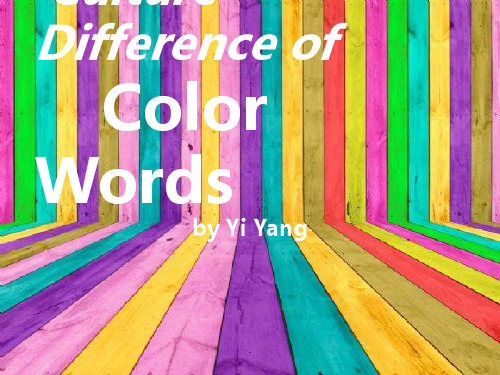
BIACK
.
BLACK in china
black was regarded as the king of all colors in ancient
颜色 china and the single color
worshiped the longest.
black also symbolizes death, fear and illegal forces.
颜色 and heavy mood.
So, black is usually associated with hopelessness,gloominess, wickedness, even to express anger and death.
16
Evil
.
Dark
.
YELLOW
.
Yellow in china
Power, majesty the centre is yellow
颜色
20
.
.
Yellow in western culture
yellow symbolizes abjection, suspicion.
颜色 Because of Judas,
who betrayed Jesus, wore a yellow robe.
9
WHITE in western culture
In western culture, a bride wears a long white skirt and veil and holds a white lily at the wedding ceremony, because the color traditionally symbolizes purity, holiness, cleanness, openness, truth, honesty, kindness .
中西颜色差异英语
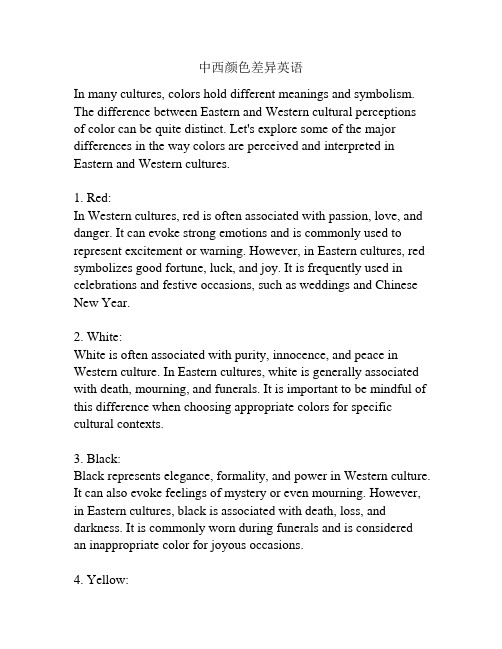
中西颜色差异英语In many cultures, colors hold different meanings and symbolism. The difference between Eastern and Western cultural perceptions of color can be quite distinct. Let's explore some of the major differences in the way colors are perceived and interpreted in Eastern and Western cultures.1. Red:In Western cultures, red is often associated with passion, love, and danger. It can evoke strong emotions and is commonly used to represent excitement or warning. However, in Eastern cultures, red symbolizes good fortune, luck, and joy. It is frequently used in celebrations and festive occasions, such as weddings and Chinese New Year.2. White:White is often associated with purity, innocence, and peace in Western culture. In Eastern cultures, white is generally associated with death, mourning, and funerals. It is important to be mindful of this difference when choosing appropriate colors for specific cultural contexts.3. Black:Black represents elegance, formality, and power in Western culture. It can also evoke feelings of mystery or even mourning. However, in Eastern cultures, black is associated with death, loss, and darkness. It is commonly worn during funerals and is considered an inappropriate color for joyous occasions.4. Yellow:In Western cultures, yellow is often associated with happiness, sunshine, and brightness. It can signify positivity and energy. Conversely, in Eastern cultures, yellow symbolizes betrayal, deceit, and cowardice. It is important to note that this negative connotation is not universally shared among all Eastern cultures. 5. Blue:Blue is commonly associated with calmness, stability, and trustworthiness in Western cultures. It conveys a sense of serenity and is often used to represent reliability. In Eastern cultures, however, blue is associated with immortality and is often used in religious or spiritual contexts.6. Green:In Western cultures, green is typically associated with nature, growth, and freshness. It represents fertility, renewal, and prosperity. In Eastern cultures, green is associated with exorcism and infidelity. It is believed to have the power to ward off evil spirits or bad luck.7. Purple:Purple is often associated with royalty, luxury, and power in Western cultures. It is a color that represents wealth and sophistication. In Eastern cultures, purple is often associated with spirituality, meditation, and enlightenment. It is considered a sacred color and is commonly used in religious ceremonies. These are just a few examples of the differences in color perceptions between Eastern and Western cultures. It is important to approach color symbolism with cultural sensitivity andawareness, especially when engaging in cross-cultural interactions, marketing, or designing. Colors can carry deep cultural meanings and understanding these differences can help facilitate better communication and avoid unintentional misunderstandings.。
- 1、下载文档前请自行甄别文档内容的完整性,平台不提供额外的编辑、内容补充、找答案等附加服务。
- 2、"仅部分预览"的文档,不可在线预览部分如存在完整性等问题,可反馈申请退款(可完整预览的文档不适用该条件!)。
- 3、如文档侵犯您的权益,请联系客服反馈,我们会尽快为您处理(人工客服工作时间:9:00-18:30)。
文化差异原则1. 2、3、黄色4、蓝色5、文化差异问题是一个非常复杂的问题,英汉颜色词语的词义有时对应有时相佐,有时无对应。
译者要在两种语言之间进行翻译,不仅要掌握两国的语言文字,而且要深刻理解两种文化之间的差异,在翻译时应该仔细推敲,谨慎处理。
2. 动物差异语言是人类社会进行交际的重要工具,同时也是文化的重要载体。
不同民族的语言既受到本民族社会文化的制约,又反映各白特定的文化内容。
如果某一民族的人们不了解某一特定民族的文化因素,则不可能进行有效与顺利的交流。
因此,必须把语言知识和文化知识结合起来才能顺利地进行交流。
研究对外汉语教学的专家赵贤州先生(1992)说:“跨文化交际之所以成为可能,正是人类享有某些共同的文化信息;而跨文化交际之所以产生某些偏差,是因为双方不能共享另一些有差异的文化信息”。
英汉这两种各具特色却大相径庭的语言形式,其表达方式与文化习惯存在一定差异。
这些五彩斑斓、丰富多彩的表达方式与纷繁复杂的习惯差异是由于汉民族文化与英美民族文化之间存在着民族历史、社会制度、道德信仰、文学艺术、心理特点、风俗习惯、价值观念、思维方式、生活方式以及地域风貌等等差别。
只有充分了解英汉文化的背景知识,才能进行更有效、更顺利的交际。
在英语文化中把人的某种特点与动物相比较并不常见,但汉语言中却有很多这种比喻的例子。
通过上面这个小例子,我们可以看出,如果在翻译中遇到这种与动物有关的比喻性句子时,我们一定要考虑西方文化的因素,避免用中国人的习惯说法代替西方人的习惯说话。
这里还有这些搭配并不是固定不变的,比如bull(公牛)这种动物,经常跟angry(愤怒)搭配,但它也可以跟mad腕狂)、strong(强壮)等搭配,因此千万不要搞教条,一定要灵活运用。
古代原始人与动物为伍,生活在深山密林之中,捕鱼狩猎,以野生动物为食,繁衍生长。
直到今天,动物仍然是人类生存与发展的物质基础之一,人类的生活一刻也离不开动物的存在。
正因为人类与动物相依相存,频繁接触,因此在人类语言中必然存在着大量以动物为喻体的隐喻性词语,并依据动物的外貌、习性等特征赋予它们特定的情感和喻义。
同时,又由于英汉两个民族在地域生态、历史传统、宗教信仰等文化各个方面的差异,隐喻中所含有的文化内涵也大不相同。
英语国家都把狮子比喻成“百兽之王”,比喻勇敢、威严、权势、凶猛等。
当比喻一个人勇猛时,会描述他为“ He is a lion. ”英国历史上查理一世因其“勇武善战”被誉为“the lion-hearted king ”(狮心王),史称“狮心查理王”。
正因为英语词汇lion 的这种语义,在学术界有“威望”的人,也被称为“ a literary lion ”,同汉语的“执牛耳”、“泰斗”。
[11] (P219-222)英国白豪地以狮子作为白己国家的标志,英国国徽的中心图案是lion ,因此英国又被称之为“ the British Lion ”,所以to twist the lion ' s tail 意为“向英格兰挑战” 。
“ Lion and Unicom "(“雄师” 代表英格兰,“独角兽”代表苏格兰)还是英国王室纹章上的动物。
“狮子”在汉语文化中却没有这样丰富的文化内涵。
在汉语文化中,“百兽之王”贝U非“虎”莫属。
“虎”是中国人相当熟悉的动物,在南方有华南虎,在北方有东北虎,在民间传说中有武松打虎,与虎相联系的其他故事还有不少,这里就不一一列举了。
汉语用“虎”比喻勇猛、威武,例如:“虎将”、“虎劲”、“虎威”等。
这是因为汉民族把虎看作“百兽之王”。
对中国人来讲,老虎不仅具备西方狮子的正面形象,而且还有“凶残、残忍”的反面形象。
如孟子的“苛政猛于虎”。
英语的“ Beard the lion in his den ”,对应的汉语要说“虎口拔牙”。
英语的“ an ass in lion ' s skin ”,汉语则说“狐假虎威”。
英语民族也常用“狮子”来形容处于主宰地位的人,如一位在家凌驾于丈夫头上的主妇,按照英语民族的习惯应称为“lioness ”。
但这样的人按汉语文化习惯则为“母老虎”。
人类的共性不言而喻,不同的民族由于在地理、民俗、宗教及价值观等方面存在差异,因此每一个民族的心理特征表现方式几不尽相同,相同的动物在不同的民族文化中有不同的意蕴,如英汉文化中同时存在的动物:龙、牛、喜鹊、蝙蝠、杜鹃、马、猫头鹰、狗等。
“ Horse ” (马)在古代英语民族作为主要的使役工具,曾起过重要的作用。
因此在英语文化中它是勤劳和吃苦耐劳的象征。
“牛”在中国悠久的农业史上是主要的农耕劳作工具。
耕牛与农民朝夕相处,且勤劳忠厚,白然赢得中华民族对牛的赞誉和热爱。
古往今来,汉语文化中有不少名家皆喜欢以牛白喻:南宋名臣 -李纲在〈〈病牛》中将白己比喻为牛,鲁迅曾有“俯首甘为孺子牛”的名句。
由于“马” 和“牛”在英汉文化史上所起的相似作用,因此它们在英汉文化中常被用作表达具有相似喻义的喻体:He is a horse. (他有牛劲。
)Horse power (力壮如牛)[12] (P235-245)这里分别比喻“健壮”和“力大”相应的汉语中的喻体则是“牛”,如“壮如牛”、“牛劲”、“老黄牛”。
“ Magpie ” (喜鹊)在英语文化中是报凶不报喜的,所以英语民族的人们认为此鸟为不吉利的征兆,因而讨厌它,而汉语言中的喜鹊是“喜庆”的象征,如“喜鹊叫,好事到”。
民间传说故事中,喜鹊是成人之美的瑞鸟,提及喜鹊,就往往会联想到牛郎、织女的“鹊桥相会”。
同样“ bat ” (蝙蝠)因其丑陋,凶恶,吸血鬼的外表形象,所以英语民族对它无好感,总是把它同罪恶或黑暗势力相联系,特别是“vampire bat ” (吸血蝙蝠)更令人感到恐惧。
与此相反,在中国的传统文化中,由于蝙蝠的“蝠”与“福”同音,因此蝙蝠便成了“吉祥”、“健康”、“幸福”的象征。
:1 3 ] (P9-11)蝙蝠与桃组成的谐音图案为“福寿双全”;蝙蝠与鹿组成“福禄双全”。
这里因文章篇幅所限,就举这些例子。
3. 数字翻译6, 8 , 9 , 7, 4 , 13 ,数字的文化信息差异数字广泛用于文学、艺术作品当中,承载着许多文化信息。
但由于不同民族在历史文化、宗教信仰、民族文化心理等方面存在着差异,由此赋予数字文化信息也存在差异。
a. 习惯表达差异例l : Groups of cavalry orderlies in threes and fours ran across the riverbed by the ranks of thetroops .译:一队队骑兵侦察员和三五成群的骑兵通信员,从部队行列边的河槽里跑过去。
英语用的是“三三四四”而汉语却是“三五成群”,这并非译错,而是各个民族表达习惯不同。
例2: Nine times out of ten the train is late译:火车十有八九部晚点英语用的是确切的数字“十有九次”,而汉语却是一个约数“十有八九”这也并非译文出错,而是因为各民族表达习惯不同,事实上英语原文也是一个约数,并非确切的统计,收稿日期:2008— 01〜15作者简介:曾邵求(1966-),男,湖南邵东人,长沙理工大学外国语学院讲师,研究方向为外语语言文化研究。
相当于“总是”。
英汉数字表达的习惯差异,体现出各白的文化特征,其中的数字都是约定俗成的,不能随意更改。
b. 模糊语义的语用差异数字是概念和符号的结合,它的基本功能是计算,但在民间语言和文学作品中数字往往并不表示确切的数量概念,而只是一个泛化的虚数,这就是数字的模糊语义现象。
数字的模糊用法一般具有较鲜明的民族性,它是民族文化长期积淀的结果。
例:she has to do all the cleaning and washingand cooking and shopping and a hundred and one other things译:她又要洗、又要涮、又要做饭、又要买菜,还有没完没了的其它事情。
由于英汉民族文化的差异,英汉语中数字的虚指意义并不等同,汉语数字虚指多借助“一至十”,“百、千、万”等数字。
如,宋代理学家邵康节写的一首五绝:一去二三里,烟村四五家,亭台六七座,八九十枝花。
全诗二十字却把数字一至十完美地镶进去了,这里的数字并无确却的数量含义,而是十分模糊的含义,表达的是一种数字美,它带给人更多的是对清新别致、恬静宜人的田园风景的欣赏和赞美。
又如:百战百胜、百感交集、千载难逢、万分感谢等中的“百、千、万”均指模糊语义。
而英语数字虚指多用较大数目的数字,如a hundredand one(许多)、a thousand and one ways(千方百计)、the eleventh hour(最后时刻,危急的时刻)、a thousand miles away(千里之遥)等等,这些数字均指虚数。
c. 喜忌偏好差异数字文化的重要内容是数字禁忌和偏好,对数字或日期的崇信和禁忌是世界各民族共有现象,但由于各民族受到历史渊源,宗教神话及民族文化心理等因素的影响,各民族对某些数字的喜爱和忌讳也各有不同。
[NextPage]众所周知,中国人对双数情有独钟。
在中国传统文化里,事物由阴、阳两方面构成,只有阴阳结合,才能滋生万物。
中国古代哲学家老子认为,任何事物都有相对的两面:如好和坏、对和错、长和短、明和暗、动和静。
在这种文化关照下,双数在汉语中蕴含着吉祥的文化内涵。
中国人喜欢双数的偶合义,追求“好事成双”,渴望“双喜临门”。
形容处事有方是“四平作稳”、百事顺心是“六六大顺”,美不可言的境界为“十全十美”。
由此可见中国人对双数的崇拜。
又比如“六”在中国人眼里是最吉祥不过的数字,俗语“六六大顺”便是最好的印证,人们尤其钟爱尾数为“ 66”、“666”、“6666”这几组数字,因为它们象征着顺顺利利、万事如意,而英语“six ”却是一个不受欢迎的数字,人们视6为大凶数或大野兽,这在下列习语中可以体现;如at sixes and sevens(乱七八糟、糊涂)hit sib for six(给人以毁灭性打击)Six to one(六对一,相差悬殊)sixpenny(不值钱)等。
双数在西方英语文化里没有受到如此高的礼遇,相反,他们却偏好单数(当然,5和13除外)视单数为吉利、祥和的象征。
他们在表示更深程度时,常在整佰整仟的偶数后面加尾数“一”。
如:onehundredandone(十分感谢);have one thousand and one things to do(日理万机);a thousand and one ways to help(许多的方法)等等。
另外,由于受基督教文化的影响,西方人对“三”和“七”也推崇备至。
